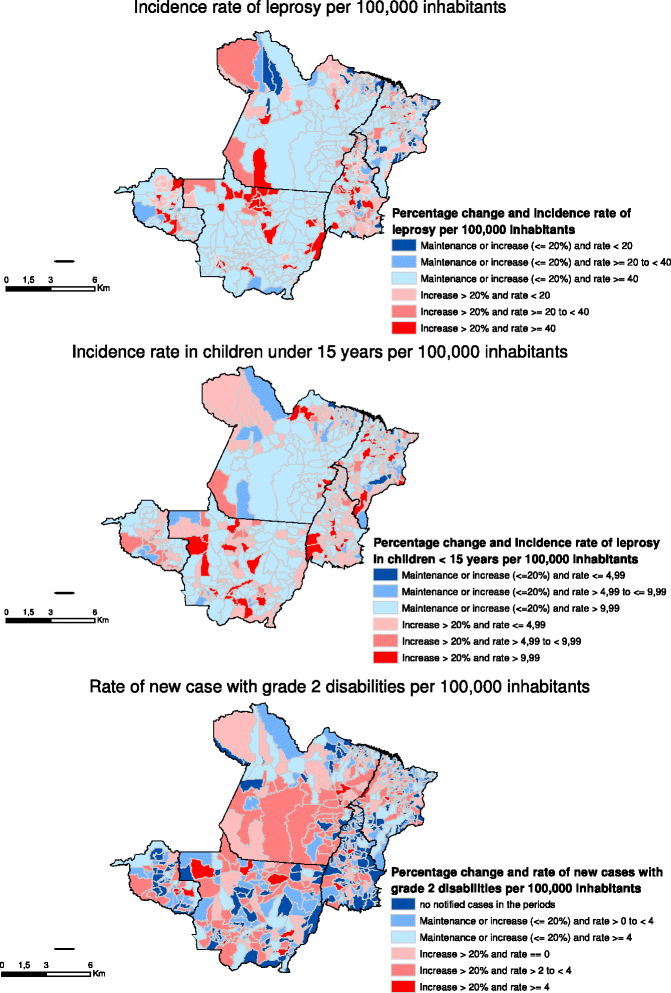Trends of main indicators of leprosy in Brazilian municipalities with high risk of leprosy transmission, 2001-2012
- PMID: 27595751
- PMCID: PMC5011946
- DOI: 10.1186/s12879-016-1798-2
Trends of main indicators of leprosy in Brazilian municipalities with high risk of leprosy transmission, 2001-2012
Abstract
Background: Leprosy incidence has reduced in recent years in Brazil, although the disease still persists as a public health problem in some regions. To investigate the trends of selected leprosy indicators in Brazilian municipalities with high risk of transmission is essential to provide effective control of the disease, yet this area has not been investigated.
Methods: This is an ecological time-series study with multiple groups using Notifiable Diseases Information System (SINAN) data. All 692 municipalities of the states of Mato Grosso, Tocantins, Rondônia, Pará and Maranhão were included. The incidence rates of leprosy were calculated, as well as incidence rates in children under 15 years per 100,000 inhabitants and rates of new cases presenting grade-2 disabilities per 100,000 inhabitants. Joinpoint Regression was used to analyse the time trends of the different indicators studied. The spatial distribution of temporal variations of the indicators in the period was presented.
Results: Between 2001 and 2012, 176,929 leprosy cases were notified in the area studied, this being equivalent to 34.6 % of total cases in Brazil. In the aggregate of municipalities, there was a reduction in incidence rate of leprosy from 89.10 to 56.98 new cases per 100,000 inhabitants between 2001 and 2012, with a significant reduction between 2003 and 2012 (APC: - 6.2 %, 95 % CI: -7.2 % to -5.2 %). The incidence rate in <15 years also reduced significantly between 2003 and 2012 (APC: -5.6 %; 95 % CI: -7.2 % to -4.1 %). The rate of new cases with grade 2 disability remained stable between 2001 and 2012 (APC: -1.3 %; 95 % CI: -2.6 % to 0.1 %).
Conclusion: Despite the reduction in the leprosy incidence rate, strategies for controlling this disease need to be enhanced to enable early case detection, especially in hyperendemic municipalities, in order to prevent disability.
Keywords: Ecological studies; Epidemiology; Leprosy; Surveillance; Trends.
Figures
References
-
- World Health Organizanization (WHO) Global leprosy update, 2014: need for early case detection. Weekly epidemiological record, 90(36) Geneva: WHO; 2015. pp. 461–476. - PubMed
-
- Brasil. Ministério da Saúde. Secretaria de Vigilância em Saúde (SVS) Saúde Brasil 2013: uma análise da situação de saúde e das doenças transmissíveis relacionadas à pobreza. Brasília: Ministério da Saúde; 2014.
-
- Barreto ML, Teixeira MG, Bastos FI, Ximenes R, Barata RB, Rodrigues LC. Successes and failures in the control of infectious diseases in Brazil: social and environmental context, policies, interventions, and research needs. Lancet. 2011;377:1877–1889. doi: 10.1016/S0140-6736(11)60202-X. - DOI - PubMed
-
- Alencar CH, Ramos AN, Barbosa JC, Kerr LRFS, De Oliveira MLW, Heukelbach J. Persisting leprosy transmission despite increased control measures in an endemic cluster in Brazil: the unfinished agenda. Lepr Rev. 2012;83:344–53. - PubMed
MeSH terms
LinkOut - more resources
Full Text Sources
Other Literature Sources
Medical



